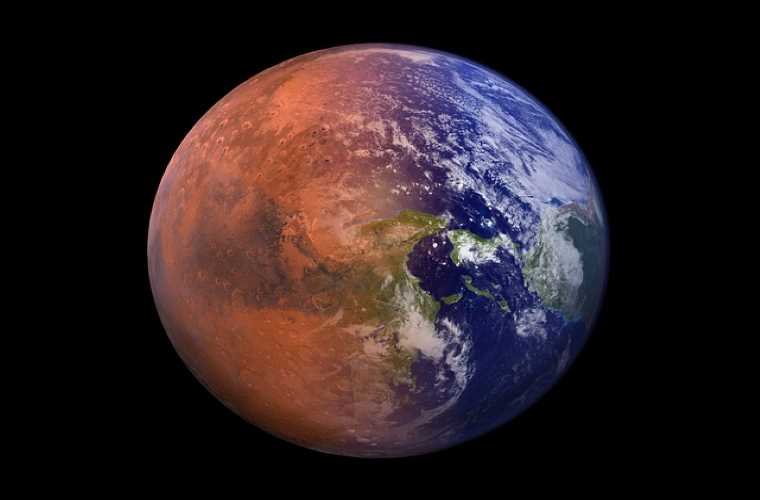If humans are to be free to walk casually around Mars without relying on technology to keep them alive, the entire planet would need to undergo the process of terraforming. Creating a breathable atmosphere, abundant water, and sustainable sources of food would be great for us, but we’d also have to know if there are any “Martians” currently residing there and decide if we have the right to replace them.
In a month where three different missions to Mars successfully arrived at the red planet, there seems to be an understandable increase in excitement on the part of the public. One of the main focus points of all of this research is the ongoing search for water on Mars because where there is water, there is hope for finding life. We’ve already established that there is water on Mars, though it doesn’t last very long on the Martian surface except in the form of ice near the poles.
Some adventurous souls, including Elon Musk, have more bold plans for Mars than simply poking around and drilling holes with robotic probes. Crewed missions to that planet will present tremendous challenges, but they may offer a lot more flexibility in our search to find out if there was a Second Genesis on the surface of our celestial neighbor. The answer to that question could have profound implications for humanity and how we view our place in the universe.
There is an even more grand objective that has been the subject of both science fiction and serious scientific inquiry for decades. Visiting Mars and living in artificial habitats, as Mr. Musk envisions, is one thing. But what about a permanent human population on the red planet?
The fundamental question of life on Mars
As our missions to Mars probe more deeply, it’s hoped that we’ll be able to determine if there is any life to be found. Perhaps some organisms are left over from an age when the planet is believed to have boasted far more habitable conditions. If there is absolutely nothing living on Mars, then the question is moot, and humanity can probably do as it wishes with the new real estate. But there may be extremophiles residing under the surface. Or possibly something a bit larger, akin to worms or insects. If there were still any herds of large land animals roaming the surface or Martian birds wheeling through the skies, we likely would have seen them by now, but that doesn’t prove that the entire place is lifeless.
Let’s assume for the moment that we eventually kick over a rock, take some samples and find some microorganisms. The first question we’ll have to answer is whether or not they are really Martians. To determine that, we would have to rule out the possibility that the life we “discovered” was something that tagged along from Earth on one of our probes.
Some scientists are convinced that it’s already happened, but until we find something that appears to be life outside of our own probes and facilitate a way to test it to be sure, this remains an open question.
How do we proceed if there was a Second Genesis?
If we have successfully ruled out Earthly contamination and discovered that a genuinely separate strain of life is living under the crust of the Martian surface, what happens next? Obviously, we would want to study it and learn how and where that life evolved. We would also want to determine if it posed any threat to human life. These are all critical questions.
But we’re talking about the possibility of terraforming the planet here. Whatever hypothetical life we find on Mars would be adapted to the wholly inhospitable (for humans) conditions there. We’re looking at the Martian surface’s current conditions where a human being without a spacesuit would die a rather horrific death in less than a minute. If we somehow modified the Martian environment to be a close enough match to the one we evolved in for us to survive, we would almost certainly kill off any Martian life living there now.
In other words, shortly after discovering the Second Genesis, we would embark on the next genocide. Some of you might be thinking, “Well…it’s just microbes and maybe some worms or bugs.” But does that justify our actions? Do we have the right to extinguish all life on another world to create more room for ourselves?
Before we worry about all of that, could we even pull off terraforming?
The issue of whether humans could convert Mars into Earth 2.0 has been studied for quite a while. The answer, at least according to NASA, is no. Or at least it’s not possible with humanity’s current level of technology. Though much of the Martian atmosphere is composed of carbon dioxide, it’s only 1% as thick as the air on Earth. There is not enough CO2 remaining in the Martian atmosphere to provide significant greenhouse warming. Further, it’s unclear if Mars is even capable of holding onto any significant amounts of gas released into the atmosphere because it’s lost most of its magnetosphere, and the solar wind would probably strip it away.
So what if terraforming isn’t even an option? We, as a species, still must deal with these ethical questions. NASA is saying is that we can’t do it today. But with some significant technological breakthroughs, it may be possible in the future. And the day may come when terraforming Mars will begin looking attractive.
Eventually, our Sun will begin expanding as it transforms into a red giant, and the Earth will become uninhabitable. Simultaneously, Mars could undergo a resurgence with a considerably warmer climate that could last for millions of years.
Conclusions
If we import some of our own microbes to Mars and they take over the place, wiping out the remaining native species, it will be far too late for the Martians when that day comes. But would that happen? Our Earthly microbes may have the same chance of surviving on Mars as Martian microbes would on Earth, which could well be near zero. One scientist once described the situation as being akin to transporting a dozen exotic birds from Asia to another continent. If you set them loose in the Amazon, they might act as an invasive species and take over the continent in a few generations. But if you dumped them out with the penguins in Antarctica, you’d wind up with a dozen dead parrots in less than a day. Perhaps the same case would apply for Martian and Earthly microbes.
At this point, we still don’t know for sure. Life is incredibly tenacious, as we have learned from our adventures in low-Earth orbit. We have discovered plankton growing on the exterior side of a window on the International Space Station. If life can hang on in the vacuum of space, it can probably survive on Mars. So these aren’t fictional hypotheticals we’re discussing. We should have a plan in place before we cause a far larger problem than the ones we’re currently trying to solve.

